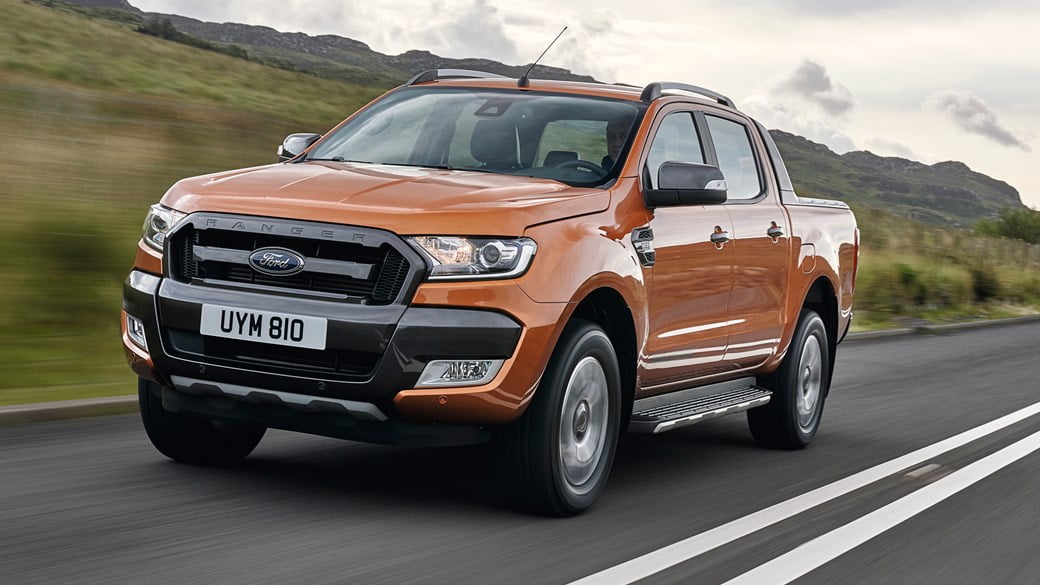
The third-generation Ford Ranger set a new standard when it was launched back in 2011, with car-like comfort and handling, low running costs and a 3.5t towing capacity.
But with the bar raised even further by newer competition, will this modest facelift be enough to keep the pickup punters keen?
Meaner and bolder; inside and out
On the outside, chief designer Craig Metros was tasked with creating a tougher, more solid appearance. He achieved this by squashing and squaring the headlights for a ‘glaring’ effect, and installing the thick three-bar grille look from the Ford F150. Meanwhile, the grille’s been given a hexagonal outline to mimic the rest of the Ford LCV line-up.
A more subtle approach has been taken inside; the previous model’s funky G-Shock watch-inspired dashboard styling has been replaced by a more conventional centre console and a new 8in touchscreen with Ford’s ‘SYNC 2’ interface (voice control, emergency assistance and access to smartphone apps including Spotify), standard on both the Limited and Wildtrack trim levels.
Other newly added driver assist features include camera-guided lane keeping alert (sounds an alert if the truck’s drifting out of its lane) and lane keeping aid (actually applies some torque to the steering to guide it within its lane). Adaptive cruise control, front and rear parking sensors and a new, bigger rear view camera display also make an appearance.
A solid all-rounder
The Ford Ranger is the Freddie Flintoff of pickups; a good all-rounder. Getting the axle articulation right for both on- and off-road use isn’t easy; too much and the vehicle can generate an uncomfortable amount of bodyroll in the bends, while too little reduces the amount of tyre contact on rough terrain. The Ranger strikes a good balance.
Good news for those who like power on an industrial scale is that the 3.2-litre 197bhp/347lb ft five-cylinder brute will continue in Euro-6 specification, which means it will still be available after September 2016. Due to its 2.2-tonne unladen weight, the 3.2-litre Ranger isn’t quite as spritely as those figures might suggest, achieving 0-62mph in 10.4 seconds.
Another drawback is the noise; heavy acceleration away from the lights produces more decibels than a Concorde take-off. However, the colossal torque output makes it the most capable of any pickup engine available in the UK. There’s little else out there to trouble its 347lb ft of torque.
This advantage is most evident off the beaten track. Combined with the electronically selectable 4WD system (with three modes: 2High, 4High, 4Low), the immediate availability of torque meant there was no need to drop into first even on 35-degree ascents when we tested the Wildtrack off-road. The extremely low second gear and hill descent control add stability on the way back down.
A 2.2-litre four-pot is also available, but the Wildtrack is available only with the 3.2.
An ideal workhorse
At the business end, very little has changed on the facelifted Ford Ranger but, then again, it never really needed to. The pre-facelift model was the first to offer a 3.5t towing capacity (although it has subsequently been joined by the Isuzu D-Max and Nissan NP300 Navara) and the 1549mm long by 1560mm wide cargo bed is one of the largest in the double-cab sector.
The main issue is payload. The extra weight of the 3.2-litre engine and Wildtrack accessories, like the side bars, roll bars and the electronically adjustable seats, eats into the payload and leaves just 1033kg left for the load on the Wildtrack.
While this is still above the one-tonne threshold for claiming back VAT, it means careful calculations must be carried out before fitting any further optional extras, like canopies and roller shutters.
Verdict
The facelifted Ford Ranger adds a more distinctive and powerful look, fuel efficiency and new levels of comfort to the pickup’s traditional strengths of practicality and versatility. However, there are a few areas where the Ranger could find itself falling behind in the next couple of years.
It isn’t the most refined pickup, with high levels of road and engine noise is the cab, for starters. Also, while the ride may currently be one of the best in its class, the new multi-link leaf-spring suspension on the Nissan NP300 Navara (which will also feature in the upcoming Renault Alaskan and Mercedes-Benz GLT) offers far better handling on tarmac.
[“source-carmagazine”]





